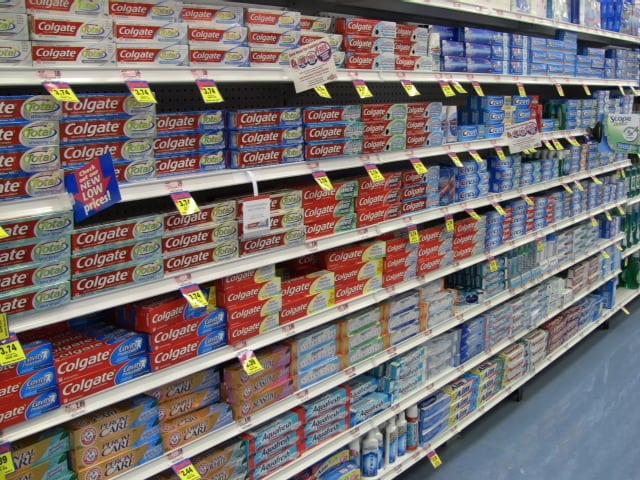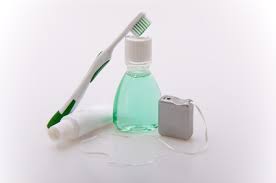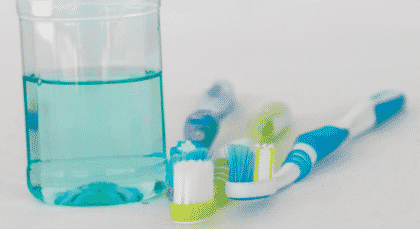Going to the grocery store for any reason can sometimes become an overwhelming experience. Aisles and aisles of food, pet supplies, hygiene supplies, cleaning supplies, flowers, baked goods, deli foods, meats, cheeses… the list alone is exhausting. And what if you just need a few things? Like a new toothbrush, some floss and a decent tasting, but effective toothpaste? Have you been down your local grocery store’s dental product aisle? With oral care becoming less of a boring chore and more of a glamour statement in our culture, what used to be a few kinds of brushes, pastes and mouthwashes sharing space with eye and ear care products have now inherited their own aisle. In some cases, both sides of the aisle.
There is an oral hygiene revolution consuming this country. Not necessarily for the sake of healthy teeth, but for perfectly straight and brilliantly white glamor teeth. And because of this desire for a mouth make-over, major manufacturers of dental products have started coming out with newly improved versions of basic products. Now there is a barrage of dental products being advertised on every conceivable media outlet possible. So how does a consumer know what it the proper product for their needs?
Choosing the Proper Dental Product for Your Own Needs
The first thing to do is ALWAYS talk to your dentist. Our dentist in Madison will ask the same questions; How do you know what your needs are? Your dentist will tell you. Your dentist will tell you if you have periodontal disease, or gingivitis. Your dentist will know if you have sensitive gums and will tell you the best kinds of floss to use. Your dentist wants to make sure you take proper care of your teeth, and will be able to suggest the proper products for you to use to achieve great oral health. You may even be looking for advice for your children, our pediatric dentists in Madison are qualified to help.
Now, let’s say you have fairly good oral health. No periodontal disease, no gingivitis or other concerns. Your teeth are a normal shade of white and your gums are pink and happy. What products will help you continue on this successful course?

Let’s look at the most basic tool needed, the Toothbrush
A toothbrush is an instrument consisting of a head with tightly clustered bristles mounted to a handle. That is the basic description of a toothbrush. In the early days of oral care, toothbrush handles were typically made of flatly carved bone, ivory or wood, and the bristles were gathered boar or horse hairs–or any other stiff hairs easily found. It wasn’t until the early 1980s, when Johnson and Johnson first introduced the Reach brand toothbrush, that the head of the toothbrush became angled for a more effective cleaning.
The Reach toothbrush differed from previous toothbrush designs in three ways:
- It had the angled head, similar to dental instruments, to clean back teeth;
- The bristles concentrated more closely than other brushes to clean each tooth more thoroughly;
- Reach toothbrushes were the first brushes to have the outer bristles made longer and softer than the inner bristles to clean between the teeth.
Soon after this toothbrush revolution, other manufacturers followed suit.
Nowadays, you can’t avoid the angle headed, multi-bristle structured toothbrush. So how do you know which toothbrush is right for you? Well, in this case, size matters. Using smaller brush heads works best because they can get to the back teeth much easier. Also, make sure the bristles are labeled as soft. Using hard bristles can result in gum damage and recession. Hard bristles were meant to be used on dentures, not human teeth. Whether you use soft or extra soft depends on your preference and gum sensitivity.
Electric Toothbrushes vs. Manual Toothbrushes
But what’s that you ask? Is it better to use an electric toothbrush or a manual one? Well, most dentists will tell you, yes, an electric toothbrush is going to do a better job. And it’s true. Electric toothbrushes remove 11% more plaque, reduce gingivitis by 6% and reduce gum bleeding by up to 17% compared to manual brushes. And now most electric toothbrushes come with all sorts of bells and whistles. No, really. There are several electric toothbrushes on the market right now that have a timer, so you can make sure you are brushing for the recommended 2 minutes. Most of them now have sensors that flash or beep to warn you that you are brushing too hard. And there are even a couple that have the same sort of sensors as vacuums that will tell you if a tooth needs a little more brushing before it’s “clean”.
But don’t throw away all your manual toothbrushes just yet. What if you woke up late and don’t have time to brush your teeth, shower and get ready? A manual toothbrush is very handy to use in the shower while you’re waiting to wash out the conditioner. Some manual toothbrushes don’t travel as easily either. A manual toothbrush is the traveler’s best friend.
Toothpaste – Let’s break it down

Aquafresh, Arm and Hammer, Colgate, Crest, Rembrandt, Sensodyne… oh my! There are over 50 different brands of toothpastes (most of which are sold in the United States). Each brand has several different categories such as whitening, tartar control, or fresh breath, with or without fluoride, cavity protection… and anything else you might be able to consider. And within each of those categories you then have to decide on flavors, paste or gel and the other subcategories like cavity protection WITH whitening. It is absolutely overwhelming. With such a vast collection of toothpastes, all claiming different functions, in different flavors, with bright shine packaging and eye catching terms and phrases, how is a consumer to know which toothpaste best suits their individual needs?
After discussing your oral care concerns and needs with your dentist, he or she will give you an idea of what type of toothpaste would work best for you. Many dental offices work with larger, name-brand manufacturers such as Colgate or Crest and may suggest them by name, but that’s because they are more familiar with those toothpastes. Here’s a little secret. The name of the brand does not matter! The color of the packaging does not matter! The eye catching terms and phrases are only there to catch your eye, they do not matter! The price does not matter!
What matters are the ingredients in the toothpaste.
- Sodium Fluoride and Stannous Fluoride are for the protection against cavities and gingivitis.
- Calcium Carbonate and Hydrated Silica are used to remove stains, plaque and calculus by “polishing” the teeth.
- Sodium Lauryl Sulfate is used to remove bacteria and for the general cleansing of your mouth.
- Calcium Phosphate is a remineralizer to enhance and restructure tooth enamel.
- Sodium Polyphosphate is for tartar control.
- Sodium Hydroxide is the most common whitening ingredient.
- Potassium Nitrate and Strontium Chloride helps to reduce sensitivity.
- Powdered Mica is that sparkly, shimmery stuff in the toothpaste that also helps to polish teeth.
So what does this all mean?
Cavity fighters
Well, if you are looking for a toothpaste specifically to protect against cavities, gingivitis and bacteria build up, you want to make sure your toothpaste ingredients include sodium fluoride, calcium carbonate or hydrated silica, sodium lauryl sulfate and sodium polyphosphate. Everything else would be window dressing for you.
Sensitive teeth
If you suffer from sensitive teeth, or have a sensitive kiddo in need of a pediatric dentist like ours in Madison, be sure your toothpaste contains some amount of fluoride, sodium lauryl sulfate, calcium phosphate and potassium nitrate. The fluoride and sodium lauryl sulfate will remove and reduce the amount of plaque and calculus eating their way through your tooth enamel. Calcium phosphate helps to strengthen tooth enamel by redepositing calcium into the weaker areas of the teeth. And potassium nitrate gets into the microscopic pores of the tooth to calm the hypersensitive nerve endings in exposed dentin.
Shiny and white teeth
If you want something to make your teeth shine whiter, look for these ingredients in your toothpaste: fluoride, calcium carbonate or hydrated silica, sodium lauryl sulfate and sodium hydroxide. These all work together to remove stains and polish the teeth. If you see powered mica, that’s a bonus!
The other ingredients
The rest of the ingredients often listed, such as trisodium phosphate, glycerin, sorbitol, cellulose gum, sodium saccharin and sodium benzoate (and much more) are added to keep toothpaste from drying out into powder. They keep the flavor from getting stale. And they determine whether the toothpaste is actually a paste or a gel. So they are very common and make up the majority of the inactive ingredients list, but are not as important to look for as the ones listed above.
Mouthwashes – Let’s break these down

Mouthwashes are an antiseptic solution intended to reduce the microbial load in ones mouth. And they come in as many varieties and versions as toothpastes. You can find mouthwashes in every color you might want. In nearly any flavor you might like. Mouthwashes are marketed in bright colored packages with the same eye catching terms and phrases as toothpastes. Sometimes, a brand will create an entire line of matching products to achieve the “absolute best oral health goal.” And sure, it may seem like a good idea to stay within the same brand and use the same “whitening” or “sensitivity” line from that brand. But just like toothpaste, most of that is window dressing. Names, labels, colors and catch phrases don’t really matter. Just because something is more expensive doesn’t mean it’s better. To find the right mouthwash for your individual needs, you just need to read the ingredients list.
Most mouthwashes have alcohol as the main ingredient. It’s a very heavy-duty antiseptic. It will kill those plaque-causing germs hanging out in your mouth. But it also helps carry the flavor. However, it may initially cause the mouth to feel dry, which can cause bad breath upon first use. After the first few times of use, the mouth gets used to the alcohol, and the good bacteria in your mouth become more resistant to the effects of the alcohol and eventually the bad breath will subside and you will be left with a healthy mouth. Nowadays, however, you can also find no-alcohol mouthwashes. Which is merely a personal preference.
If you have significant pain in your mouth, maybe from eating, perhaps that cheese on your pizza gave you a blister on the roof of your mouth, then you want to look for a mouthwash with Benzydamine in it. Benzydamine will calm the nerves in your mouth that are either damaged or exposed due to injury or illness.
If you have red, inflamed gums or other oral tissue, your dentist may recommend you find a mouthwash with Betamethasone in it. Betamethasone is an anti-inflammatory, like ibuprofen for your mouth.
Cetylpyridinium Chloride is recommended for those with chronic halitosis. It kills the bacteria and fungus that causes bad breath but leaves the good bacteria alone.
For basic anti-plaque and cavity fighting protection, and if you prefer not to have alcohol in your mouthwashes, look for Chlohexidine Digluconate and Fluoride in the ingredients.
Floss
Floss is meant for the extraction of food debris from under the gums and between the teeth. The only difference between the several brands and flavors and varieties is your personal preference. Waxed or unwaxed? Super-thin glide, thin or regular? To figure out the right floss for your mouth, you just have to experiment. Again, the price, the colors, the catch-phrases don’t mean anything. This one is all on you.
Now that you have a better idea of what is in your toothpaste and mouthwash and how your toothbrush should fit, you can brave the dental hygiene aisle at your local drugstore or grocery store with confidence that you will go home with the perfect combination of dental products to keep your mouth and teeth happy and healthy! If you have more questions or want to learn about more complex procedures Affiliated Dentists offers like cosmetic dentistry in Madison or our affordable dental care programs.


